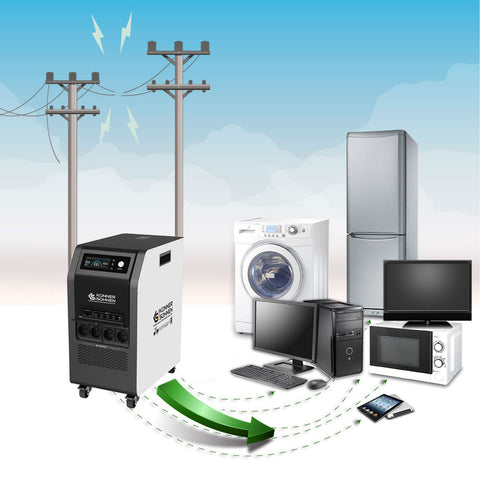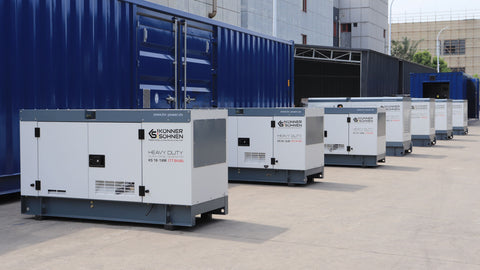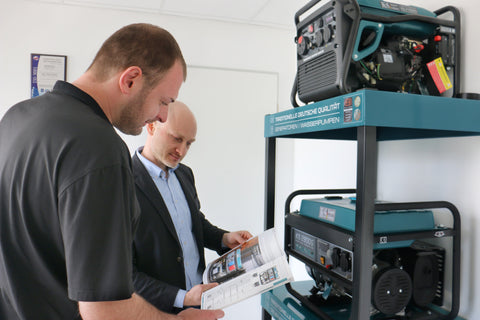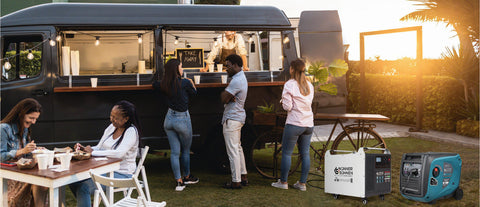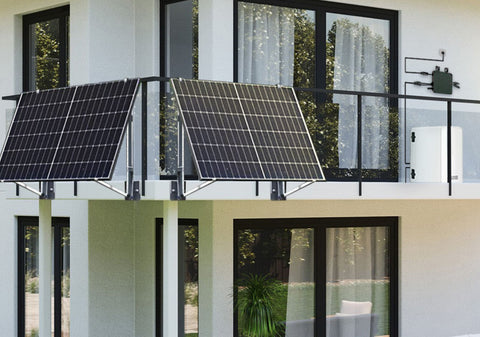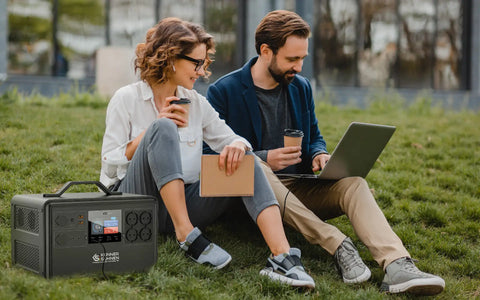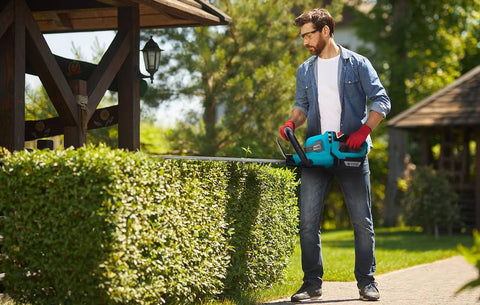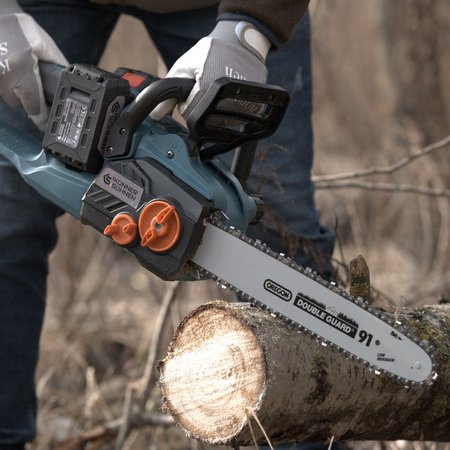This article is protected by copyright. Publication of the entire article or parts thereof without a clear reference to the source (a link to the Könner & Söhnen website) is prohibited.
Our generators are designed as IT systems and feature basic protection through basic insulation of the live components. This is a protective separation. The PE pins in the sockets, as well as the grounding screw, are connected to the body of the generator. The generator housing is insulated from the live L and N lines.
Emergency power supplies in buildings must usually be installed as a TN system. In this case, the generator and its neutral conductor must be grounded. The generator's grounding screw must be connected to the building's main earthing bar using a 6-10 mm² copper cable. If this is missing, a grounding connection must be built for the generator. The PE conductor from the generator socket goes to the grounding screw in the distribution box, which in turn must be connected to the main earthing bar. The N conductor from the generator socket must be grounded at the connection point in the distribution box. This can be done by placing a bridge between N and PE on the generator side of the transfer switch.
The generator itself remains an IT system and can therefore be easily used mobile. If it is to be used to supply a house, simply connect the generator to the grounding system, lay the cable from the generator to the power supply socket, and the system is ready for operation.
The electric stove is a 230V power consumer with a total power of over 4.6 kW, connected to three phases solely for load distribution. However, it remains a 230V power consumer, with its heating elements divided into three groups. It can be powered by a single 230V phase of the generator. However, not all cooking zones and the oven can be activated simultaneously to avoid overloading the neutral wire to the electric stove from the distribution box.
Recommended connection plan according to the VDN guidelines for the planning, construction and operation of systems with emergency power generators for 230V power consumers:


Könner & Söhnen generators with the VTS system can be used to power both 230V and 400V power consumers, but not simultaneously. The 400V mode is intended exclusively for 400V power consumers.

For emergency power supplies without an ATS, the generator must be started with the circuit breaker (on the generator) off. Then, the generator's voltage must be checked, and only when the voltage level and frequency (50-53 Hz) are correct should the circuit breaker be raised and the load connected. Before stopping the generator, the load must first be deactivated using the circuit breaker on the generator, and only then should the generator be stopped to prevent damage to the power consumers and the generator itself due to transient processes. When switching from 230V to 400V mode and vice versa, the load must first be deactivated, the mode must be changed, and the voltage must be checked. Only then should the load be activated using the appropriate circuit breaker.
Models labeled ATSR can also be operated with an external ATS box.
The KS ATS 4/63 HD box is designed for diesel generators and a 1-phase and 3-phase external power grid connection with up to 63A per phase.
The KS ATS 1/40 HD box is designed for diesel generators and a 1-phase external power grid connection with up to 40A per phase.
The power supply built into the ATS also supports the generator battery so that it always remains ready for use and in the event of a power failure the 12V power supply takes over.
The ATS control cable can also be extended. The recommended cross-section is 1.5 mm² per wire.
Here is the recommended connection plan according to the VDN guideline for the planning, construction and operation of systems with emergency power generators for 230V power consumers:

The ATS monitors the voltage on the A-phase "City Power" side and automatically starts the generator in "Auto" mode as soon as there is no voltage. After the generator starts, its voltage is checked, and the power supply to consumers eligible for emergency power is switched to the generator. The grid is disconnected across all poles. When the voltage returns to the "City Power" side, the "Load Output" is switched to the "City Power" side, and the generator is stopped.
The 100-200W base load (e.g., 2 x 100W incandescent or IR light bulbs) serves to balance the nonlinear small power consumers present in a household, such as routers, satellite switches, cell phone chargers, LED lighting, etc., which consume only a portion of the sine wave and thus distort the voltage. It is important to avoid harmonics harmful to the power consumers when such power consumers are the only ones active in the home.
The resistive balancing load loads the parts of the voltage sine wave that are not loaded by non-linear electronic power consumers and thereby dampens the harmonics.
Voltage (yellow) and current (green) of a conventional generator under electronic load without and with balancing load (100W light bulb):


You can see that the disturbing harmonics marked with the red arrows in the left image are much smaller in the right image and most electronic modules then function without problems.
In conventional generators (including those with AVR), the current is taken from the alternator winding, and the voltage waveform may deviate from a sine wave depending on the generator design and connected power consumers. The voltage frequency of a conventional synchronous generator is determined by the motor speed, which can fluctuate depending on the load. A value of 50-53 Hz is permissible and within the tolerance range.
You must ask the manufacturer of the respective device whether you are allowed to power your sensitive devices with a conventional generator, as this may depend solely on the design of the device.
Models with VTS system can also be used for emergency power supply of 400V power consumers.
Here is the recommended connection plan according to the VDN guideline for the planning, construction and operation of systems with emergency power generators for 400V power consumers such as motors, pumps, etc., which load all 3 phases symmetrically:

This solution is intended exclusively for 400V power consumers that load all 3 phases simultaneously and evenly and is not suitable for a complete house feed-in with mixed 230V and 400V power consumers!
400V three-phase current is only needed by devices that require a rotating field. These are power consumers with three-phase motors, such as tools, pumps, etc. Power consumers such as electric stoves, powerful instantaneous water heaters, fan heaters, electric boilers, and saunas are connected to three-phase current only for the purpose of load distribution in the VDN grid and are, in fact, 230V power consumers that can be supplied by a 230V generator.
230V power consumers with a total power of more than 4.6 kVA must be connected to 3 phases for load distribution when operating from the external power grid. In emergency power operation, when using a non-unbalanced load emergency power generator, they must be supplied with 230V, but must not be brought to full power to avoid overloading the neutral conductor.
Power consumers such as electric stoves are typically connected with a 5 x 2.5 mm² copper cable. Thus, when powered by the generator, a pair of cooktops, or a cooktop and an electric oven, can be operated without any problems without overloading the neutral conductor of the supply cable. Provided the generator itself has sufficient power. The same applies to instantaneous water heaters, fan heaters, electric boilers, saunas, etc., which have internal 230V heating elements and are, in fact, 230V power consumers.
Please note that our generators are equipped with circuit breakers that trip immediately in the event of a short circuit, but not in the event of a minor overload. The response time of the thermal release depends on the magnitude of the overload and can take up to 1 hour, which is typical for circuit breakers. Therefore, you must pay attention to the maximum permissible load (including reactive load) to avoid overload damage to the generator itself.
Our generators are emergency power units and are not suitable for continuous, uninterrupted operation.
We recommend running all of our diesel generators for up to 10 hours, but then taking a break of 30-60 minutes to cool down.
Disclaimer:
This manual is intended only as a guide, is illustrative, and must be adapted to the specific circumstances and conditions on site during installation. The installation itself must be carried out in compliance with all standards and regulations. We assume no responsibility for incorrect installations and their consequences.

